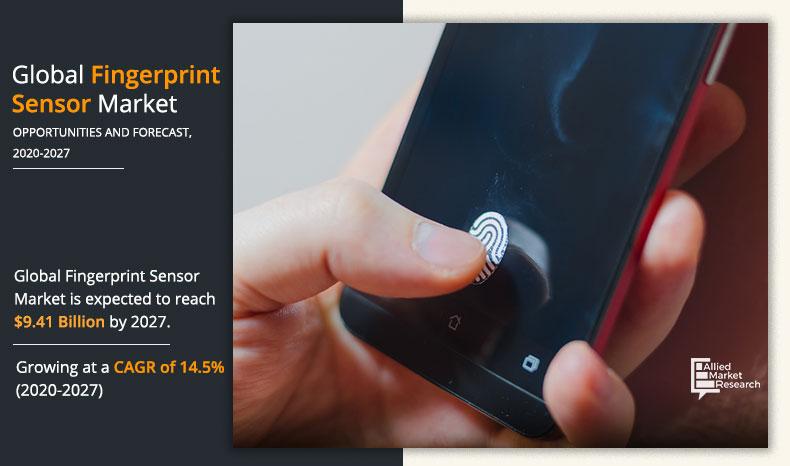Fingerprint Sensor Market Summary
The global fingerprint sensor market size was valued at $2.93 billion in 2019, and is projected to reach $9.41 billion by 2027, registering a CAGR of 14.5% from 2020 to 2027. This is driven by increased adoption of automation and wireless connectivity across industries. Growth will be especially strong in emerging regions like Asia-Pacific and LAMEA, where the rapid development of smart technologies is accelerating demand for advanced biometric authentication solutions.
Market Dynamics & Insights
The fingerprint sensor industry in Asia-Pacific held a significant share of over 49.5% in 2019.
The fingerprint sensor industry in U.S. is expected to grow significantly at a CAGR of 10.9% from 2020 to 2027.
By type, FAP 10 segment is one of the dominating segments in the market and accounted for the revenue share of over 37.2% in 2019.
By end-use, the Banking and Finance segment is the fastest growing segment in the market.
Market Size & Future Outlook
2019 Market Size: $2.93 Billion
2027 Projected Market Size: $9.41 Billion
CAGR (2020-2027): 14.5%
Asia-Pacific: Largest market in 2019
Asia-Pacific: Fastest growing market
The main features of biometric fingerprint scanner mainly include accuracy, better performance, and robustness based on exclusive fingerprint biometric technology. Fingerprint scanner is an extremely safe & suitable device. The working principle of a fingerprint sensor mainly depends on processing. Fingerprint processing mainly includes two elements, namely enrollment and matching.
Optical fingerprint sensor provide authenticated user with fast, secure, and easy access to personal contact details, emails, payment information, location data, and other types of encrypted data. Sensors for fingerprints allow fast record keeping and control of portals for attendance. Compared with other biometric authentication systems, they are less costly. These factors further increase growth of the fingerprint sensor market.
In addition, widespread use of fingerprint sensor based biometric systems by governments and law enforcement agencies to improve security drives growth of the global fingerprint sensor market share. Furthermore, rise in adoption of biometric-based time and attendance systems in corporate and government organizations for measuring hours of service for workers and productivity supports the fingerprint sensor market.
Introduction of optical fingerprint sensor in smartphones and other consumer electronics, government funding for adoption of fingerprint sensors, and use of biometrics in mobile commerce are the main drivers for the fingerprint sensor market. In addition, growth of the market is expected to increase by adoption of fingerprint sensors in smartphones to perform tasks such as unlocking phones & apps and making payments. Continuous developments and innovations in fingerprint scanning technology also support the market growth in consumer electronics.
Factors such as extensive use of fingerprint sensors for biometric authentication in consumer electronics, rise in adoption of biometric authentication in government buildings, and growth in in number of identity threats and emergence of touch less fingerprint technologies act as major drivers for the fingerprint sensor market growth globally. However, security threats pertaining to biometric database and high cost associated with biometric technologies is expected to pose major threats for the market. Furthermore, emerging trends toward IoT based biometric technology and rise in adoption of in-display fingerprint sensors in smartphones is expected to offer lucrative opportunities globally.
By Type
FAP 30 segment is projected to be the most lucrative segment
Segment Overview
The fingerprint sensor market is segmented on the basis of type, end use, and region. By type, it is divided into FAP 10, FAP 20, and FAP 30. By end use, it is categorized into banking & finance, government & law enforcement, commercial and others. By region, the market is analyzed across North America, Europe, Asia-Pacific and LAMEA along with its prominent countries.
By End Use
Banking and Finance segment will grow at a highest CAGR of 16.7% during the forecast period
Competitive Analysis
The key players profiled in the fingerprint sensor industry include Thales Group, IDEMIA, Apple Inc., Synaptics Incorporated, Egis Technology Inc., 3M Congent Inc., Crossmatch, SecuGen Corporation, HID Global Corporation and Precise Biometrics. These key players have adopted strategies, such as product portfolio expansion, mergers & acquisitions, agreements, geographical expansion, and collaborations to increase their market penetration and strengthen their foothold in the industry.
By Region
Asia-Pacific region would exhibit the highest CAGR of 16.2% during 2020 - 2027
Covid19 Imapct
The ongoing spread of COVID-19 has become one of the biggest threats to the global economy and is causing widespread concerns and economic hardship for consumers, businesses, and communities across the globe. The “New Normal” that includes social distance and working from home has created challenges with daily activities, regular work, needs, and supplies, causing delayed initiatives and missed opportunities.
The COVID-19 pandemic is impacting the society and overall economy across the global. The impact of this outbreak is growing day-by-day as well as affecting the supply chain. It is creating uncertainty in the stock market, falling business confidence, massive slowing of supply chain, and increasing panic among customers.
European countries under lockdowns have suffered a major loss of business and revenue due to shutdown of manufacturing units in the region. Operations of production and manufacturing industries have been heavily impacted by the outbreak of the COVID-19 disease; which has led to slowdown in growth of the market in 2020.
According to fingerprint sensor market trends, the COVID-19 has severely impacted global manufacturing and industrial sector as production facilities have stalled, which, in turn, have led down the significant demand in industries.
Emergence of COVID-19 has declined growth of the market in 2020, and is estimated to witness slow growth till the end of 2021. Implementation of partial or complete lockdown across various countries globally is the prime reason for this decline in growth rate. As industries were temporarily shut, it reduced the need for maintenance from various industries.
Top Impacting Factors
Notable factors positively affecting the fingerprint sensor market include extensive use of fingerprint sensors for biometric authentication in consumer electronics, increase in adoption of biometric authentication in government buildings, rise in number of identity threats, and emergence of touch less fingerprint technology.
However, security threats pertaining to biometric database and high cost associated with biometric technologies hampers growth of the market. Furthermore, emerging trends towards IoT based biometric technology and rise in trends towards in-Display fingerprint sensors in Smartphones are expected to offer lucrative opportunities for the market growth in the coming years.
Increase in Adoption of Biometric Authentication in Government Buildings
Widespread use of fingerprint sensor based biometric systems by governments and law enforcement agencies to improve security drives growth of the global fingerprint sensor market. Furthermore, rise in adoption of biometric-based time and attendance systems in corporate and government organizations for measuring hours of service for workers and productivity also supports market growth.
High Cost of Biometric Technology
High development cost of different biometric sensors is a major restraint for the market growth. Cost generated in overall production process of sensors is creating a difficult situation for consumers to afford these sensors. Cost of production of raw materials for biometric sensors has also increased substantially, restricting consumers to avail such features. Moreover, there is a very little scope for manufacturers to contain the price, owing to high cost involved in R&D activities.
Key Benefits For Stakeholders
This study includes the analytical depiction of the fingerprint sensor market forecast along with the current trends and future estimations to determine the imminent investment pockets.
The report presents information regarding the key drivers, restraints, and opportunities in the fingerprint sensor market analysis.
The fingerprint sensor market is quantitatively analyzed from 2019 to 2027 to highlight the financial competency of the industry.
Porter’s five forces analysis illustrates the potency of the buyers and suppliers in the industry.
Fingerprint Sensor Market Report Highlights
| Aspects | Details |
| By Type |
|
| By End Use |
|
| By Region |
|
| Key Market Players | IDEMIA, THALES, SECUGEN CORPORATION, EGIS TECHNOLOGY INC, SYNAPTICS INCORPORATED, 3M COGENT INC, CROSSMATCH, APPLE INC, PRECISE BIOMETRICS, HID GLOBAL CORPORATION |
Analyst Review
The global fingerprint sensors market is highly competitive, owing to strong presence of existing vendors. Fingerprint sensors technology vendors, who have access to extensive technical and financial resources, are anticipated to gain a competitive edge over their rivals, as they have the capacity to cater to the market requirements. The competitive environment in this market is expected to further intensify with increase in technological innovations, product extensions, and different strategies adopted by key vendors.
Fingerprint sensor market is expected to witness a significant growth with increase in adoption from various industries to improve operations efficiency and government safety regulations across different geographical regions. Technological advancements have augmented the overall industrial development within a wide range of industries. Consumer electronics, government, and commercial are some of the leading sectors, which use fingerprint sensors techniques to ascertain safety and security and gain operations efficiency.
Asia-Pacific is projected to dominate the market during the forecast period, owing to growth in the consumer electronics industry. The countries in this region already have an improved consumer electronics industry, with China manufacturing massive amounts of mobile phones each year. Adoption of fingerprint sensors in retail and corporate sectors, rise in fraud incidents, maintenance of safe access to physical and logical properties in commercial applications, increase in awareness among masses about benefits of using fingerprint sensing technology, and cost-effectiveness of these sensors drive growth of the fingerprint sensor market in this region.
The fingerprint sensor market provides numerous growth opportunities to the players such as Thales Group, IDEMIA, Apple Inc., Synaptics Incorporated, Egis Technology Inc., 3M Congent Inc., Crossmatch, SecuGen Corporation, HID Global Corporation and Precise Biometrics. These key players have adopted several strategies such as new product launch & development, acquisition, partnership & collaboration, and business expansion to increase their footprint in the market during the forecast period.
The global fingerprint sensor market size was valued at $2.93 billion in 2019, and is projected to reach $9.41 billion by 2027.
By region, the Asia-Pacific segment generated the highest revenue in the fingerprint sensor market forecast in 2019.
The Fingerprint Sensor Market to register at a CAGR of 14.5% from 2020 to 2027
Extensive use of fingerprint sensors for biometric authentication in consumer electronics, and increase in adoption of biometric authentication in government buildings etc. boost the Fingerprint Sensor market growth.
The key players profiled in the report include Thales Group, IDEMIA, Apple Inc., Synaptics Incorporated, Egis Technology Inc., and many more.
Loading Table Of Content...




